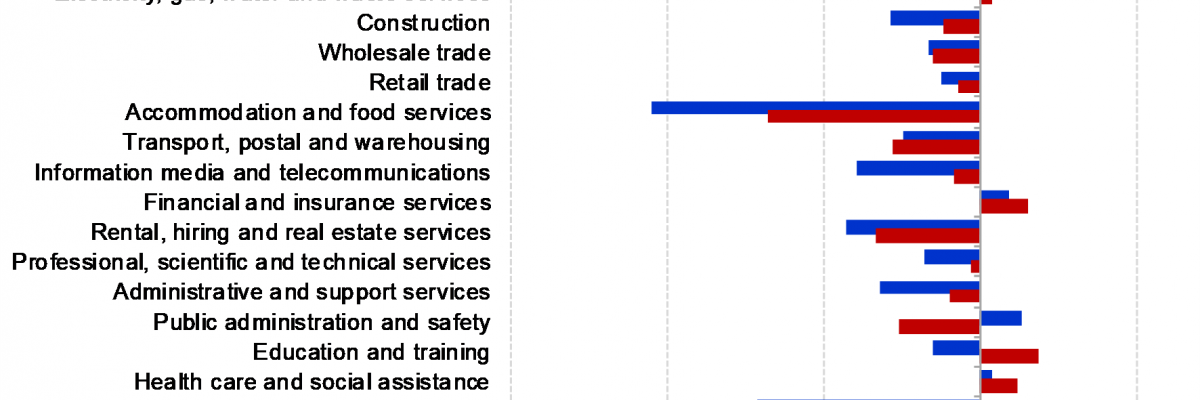Data Wrap - Job recovery continues but remains incomplete

In this edition of the Data Wrap we review the August Labour Force Survey results, and consider what the latest ABS data has to say about trends in employment by industry and residential property prices in Adelaide.
South Australian labour market continues slow recovery
The South Australian labour market continued to recover in August with employment levels recording their third consecutive monthly increase. The latest labour market report from the ABS – released yesterday – indicates that the total number of people employed rose by 1.6 per cent (13,400 persons) in August. There was a slightly larger rise in aggregate hours worked (up 1.8 per cent).
The recovery in employment was accompanied by a rise in unemployment as more people resumed looking for work. The number of unemployed rose by 1.1 per cent (800 people) in August. The net effect of these parallel movements was that South Australia’s unemployment remained unchanged at 7.9 per cent.
The gradual normalisation of labour market conditions has encouraged people to re-enter the labour force, with the participation rate rising by 1.0 percentage point to 62.8 per cent in August. But there are still a lot of people who would like to work more hours than they currently have – the state’s underemployment rate rose by 0.4 percentage points to 11.4 per cent and remains at a relatively high level by historical standards.
In spite of the recent improvement in South Australian employment levels they remain down 1.8 per cent from their pre-COVID peak in March. In comparison, national employment remains 3.2 per cent below its pre-COVID peak.
Looking more closely at the latest national results, Australia’s unemployment rate fell by 0.7 percentage points to 6.8 per cent in August. This fall was brought about by a reduction in unemployment (down 8.6 per cent) and a rise in employment. However, employment for the nation rose by a smaller margin that for South Australia (0.9 per cent compared to 1.6 per cent).
South Australia’s seasonally adjusted unemployment rate of 7.9 per cent in August was the highest of any state or territory. Queensland (7.5 per cent) also has a relatively high rate of unemployment, while unemployment in Victoria (7.1 per cent) has now risen above the national level following the re-introduction of stay-at-home orders. Unemployment is presently relatively low in the Australian Capital Territory (4.2 per cent), Northern Territory (4.2 per cent), and Tasmania (6.3 per cent).
Job recovery remains weak for hospitality and the cultural sector
ABS data on weekly payroll jobs provides timely insight into how labour market recovery is progressing at the sectoral level. Despite some recent recovery, employment levels remain well below their pre-COVID levels for social consumption industries such as hospitality and the cultural sector – see figure below. Between the weeks ending 14 March and 22 August payroll jobs remained well down for arts and recreation services (down 16 per cent) and accommodation and food services (down 14 per cent). Payroll jobs for agricultural, forestry and fishing have also decreased sharply (down 13 per cent). The extent to which the decline for agriculture reflects seasonality versus other factors such as the impact of drought, bushfires or market forces is uncertain.
The only sectors that have seen growth in payroll jobs since the onset of the pandemic include education and training (up 3.7 per cent), financial and insurance services (up 3.0 per cent), health care and social assistance (up 2.3 per cent), and electricity, gas, water and waste services (up 0.8 per cent).
Figure: Change in payroll jobs since the beginning of the pandemic
South Australia and Australia - week ending 14 March to 22 August

Source: ABS, Weekly Payroll Jobs and Wages in Australia.
Adelaide property prices fall
The economic shock of COVID-19 naturally weighed on house prices in the June quarter, but they have generally held up well considering the scale of disruption to economic activity and the property market. The ABS residential property price index for Adelaide fell by 0.8 per cent in the June quarter while the weighted average for the eight capital cities was down 1.8 per cent.
Social distancing restrictions including temporary bans on live auctions and open inspections did have a pronounced impact on market activity. The number of established house transfers for Adelaide in the three months to June 2020 was down 28 per cent from the corresponding period in 2019, while transfers in the rest of the state were down 24 per cent.
The fall in national prices in the June quarter was led by falls in Melbourne (-2.3 per cent) and Sydney (-2.2 per cent). There were also falls in Darwin (-1.4 per cent), Brisbane (-0.9 per cent), Perth (-0.7 per cent) and Hobart (-0.4 per cent). Only Canberra recorded a rise in residential property prices (0.8 per cent).
